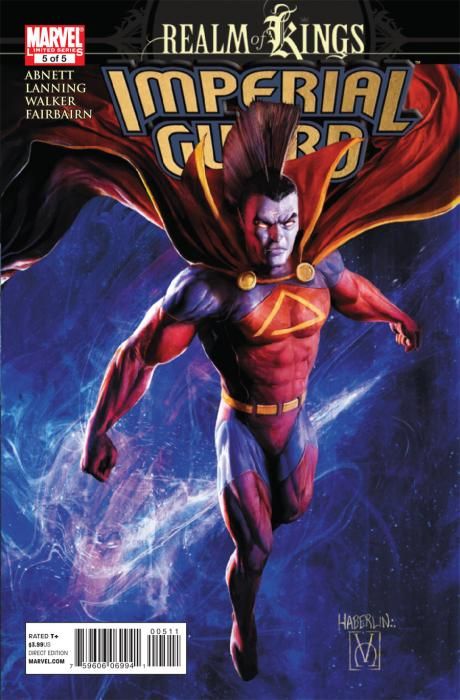The structure of the Marvel cosmic books right now is a smart one: two ongoings ("Nova" and "Guardians of the Galaxy") that focus on specific characters, and rotating mini-series to develop the alien races and concepts that may get overlooked otherwise. That structure does make the mini-series seem less important and lacking in conclusiveness since their job is merely to shed light on side characters and enhance the main thrust of the line, like tie-in books during an event. Non-essential and somewhat inconsequential. That quality is what limits "Imperial Guard" #5 as it wraps up its story, but in a manner where small plot points are accomplished and the real story will continue elsewhere.
With part of the Imperial Guard and the Starjammers trapped on the other side of the Fault, a tear in space created at the end of "War of Kings," Gladiator, newly declared Majestor, must enter the Fault with other members of the Imperial Guard to rescue their comrades. The entire series has built to the moment where Gladiator enters the fray, acting as both a leader and a warrior. The point that his warrior skills are what earned him the respect of the Shi'Ar and to avoid using them out of some sense of being a 'proper' leader is well made since the Gladiator's efforts do make a difference.
On the other side of the Fault is a universe where life runs unchecked, leading to monstrous results like the twisted version of the X-Men that the Guard face. Combinations of the familiar mutants and Lovecraftian monsters are a smart enemy to have this group face in the Fault and DnA do a good job of referencing the effect this has on the X-Men's sometimes allies, sometimes enemies, the Imperial Guard. Gladiator destroying 'Cyclops' with his heat vision is an impressive moment. And the Fault version of Xavier is the best take on the idea by far, drawn with extensive detail by Kev Walker.
I've been a fan of Walker's art for years, but his work here seems like a step down from his darker, more angular art of the past. He avoids the sharp corners and heavy shadows of previous work, opting for a more textured, cross-hatched style. It's not bad, but it's not nearly as powerful as the work he's done with DnA previously, like the "Annihilation: Nova" mini-series.
Even with this altered style, he still delivers some powerful panels, like the initial shot of Gladiator, looking powerful and impatient, ready to enter the Fault and save his Guardsmen. The looks of the Fault 'X-Men' are also done well as he merges the look of the mutants with tentacle monsters and creatures with tons of teeth. Odd that in a book that would lend itself to a darker style, he opts for this lighter one.
One of the biggest strengths of this issue is Abnett and Lanning's ability to find small character moments, giving the series its own, albeit limited, sense of wholeness. Beyond that, it's an action comic that progresses the larger story of the Marvel cosmic universe as it heads towards "The Thanos Imperative," meeting up with one of the subplots in "Guardians of the Galaxy" by the end. As far as perfunctory books go, though, it's pretty good and definitely worth it for that cosmic fan that doesn't mind spending a little extra cash to get a view of the bigger picture.

